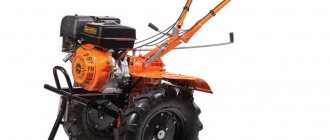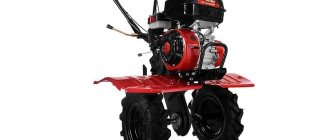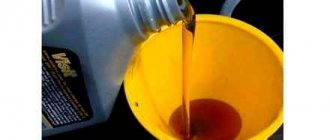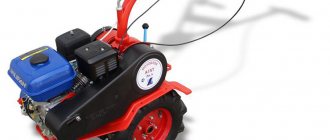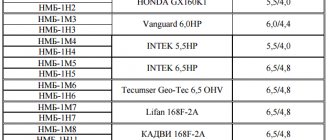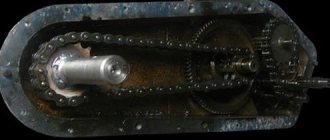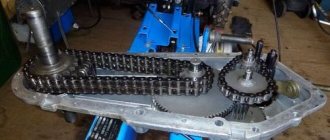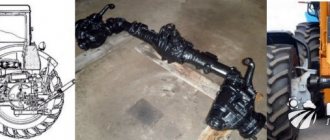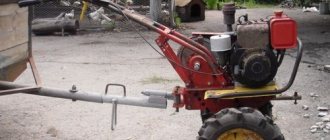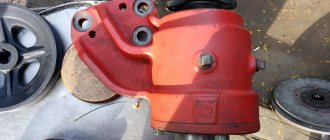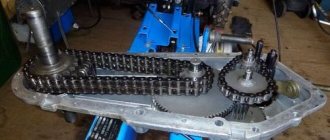.. 30 31 32 33 34 35 36 37 38 39 40 ..
Disassembly and assembly of the gearbox of walk-behind tractors Oka, Neva, Cascade (MB-1)
Disassembly and assembly of the MB-1 gearbox
The gearbox of the MB-1 walk-behind tractor is the basis on which other components and assemblies of the walk-behind tractor are mounted. Therefore, to repair the gearbox with disassembly, it is necessary to disassemble the walk-behind tractor, for which you need to dismantle the engine, steering column, pan, brackets with forward and reverse belt pulleys, gear pulley, wheels. Before disassembling the gearbox, clean it from dirt and drain the oil. Remove the rotating head from the gear shift knob by knocking out the pin holding it with a thin drift. Unscrew the locking screw 11 (Fig. 36) and remove the bushing 9 and the retaining spring 10 from the shift shaft 7. Unscrew bolts 17 (Fig. 35) securing the housing halves, then tightening bolts 7 (2 pcs.) and 10. Place the gearbox on the left half of the housing, using a thin screwdriver or knife, carefully so as not to damage the gasket, undock the gearbox halves and remove the right half. Leave the spacer washers for the tie bolts on the block sprockets. Note. It is recommended to remove only defective parts from the gearbox, without completely disassembling the gearbox. To disassemble the gear shift mechanism, remove retaining ring b from shift shaft 7 (Fig. 36), ensuring free movement of sprockets 31. 32 (Fig. 35). Remove the cotter pin 3 (Fig. 36) from the threaded part of the shift handle 1, unscrew it (counterclockwise) from the block 8 and remove the handle and the block from the shaft. Wash removed parts and replace defective parts. Replace the shift shaft seals after removing it from the gearbox. Reassemble the gearbox in reverse order. Apply a thin layer of sealant to the mating surfaces of the body halves. Start connecting the halves of the housing with the central tightening bolts 7 and 10 (Fig. 35), then the bolts for fastening the halves, starting from the middle part of the gearbox with a sequential transition of tightening the bolts to the edges. Before final tightening of the bolts, check the smooth running of the moving parts of the gearbox.
Vanya132313 › Blog › Repair of the gearbox of the Centaur or MB-1 walk-behind tractor
The gearbox on the output shaft began to leak. I looked and there is play on the shaft; replacing the cuffs will not help for a long time. It was decided to add waste to the box until the end of the season.
Centaur 3040D (diesel 4 hp)
I split the gearbox and the result is obvious. There is metallic shiny dust in the oil at the bottom of the gearbox.
Full size gearbox cover with box gears. I only removed the output shaft with bearings from the box. I did not dismantle the rest since no problems were found in the box. Full size Empty cover (second half) Full size Boots and cuffs, cap with bearing 206 closed Full size Cuff in housing Full size Same cuff on the other side
I bought replacement cuffs and bearings in advance but when I disassembled the gearbox. The idea emerged that ball bearings are not designed for significant axial loads. Therefore, they do not live long on this shaft; when turning and cultivating, axial and shock loads (forces) arise.
Full size Output shaft with bearings and possible options for replacing bearings for a more reliable option.
This is where the cage and the outer ring of the bearing burst.
Full sizeWhy do outer rings burst? And what does this threaten? How to deal with this?
Therefore, I want to install roller or tapered bearings, as they usually do on car wheel hubs. It will still be more reliable, rather than 3-4 seasons (years) for the ball ones to be nursed.
Full sizeWhich bearings are best to install?
Only with conical ones the problem is that the bearing is 1.25mm higher (not 16mm, but 17.25mm). I think I should put a 2mm paronite gasket in the plane of the gearbox connector. Try the shaft by hand; it will spin or jam the bearings (used bearings for the experiment). Or does anyone have other ideas for increasing the space for bearings?
Full sizeDisassembled in parts
There were bearings 6206 closed on one side SIZE (30x62x16) Replacement without alterations is possible with 102206 (single-row roller, not dismountable) SIZE (30x62x16) Replacement with alterations is possible with 7206A (conical roller collapsible) Moskvich hub or LuaZ SIZE (30x62x17.25). How to adjust the gap? There is a nut on the hubs for this. And here you need to take at least 2 mm. Where can I get 2 mm? I went shopping for bearings that were more reliable and durable. It turned out that in Makeevka on green there are 12206 (single-row roller, non-dismountable) and 1206 (ball, double-row, self-installing).
Full size 1206 double row ball
12206 (GPZ-10, Rostov) - 480 rubles for significant axial loads, not designed without a separator, and 1206 (China 280 rubles) GPZ-8, Kharkov - 320 rubles. in theory, withstands axial loads and two rows of balls + self-aligning.
Full size 1206 GPZ-8, Kharkov - 320 rub. in theory, withstands axial loads and two rows of balls + self-aligning.
I took 1206 (2 pieces) 640 rubles. and there is no need to redo or sharpen anything.
Full size Welded bearing seat
Upon inspection, I discovered that the bearing seats were located in the places where they were welded to the housing and were also sealed. The bearing fits easily.
Full size Designed bearing space.
Therefore, I decided to plant it in the body the old fashioned way by adjusting tissue paper. I placed the paronite gasket on one side with sealant. The output shaft rotates easily by hand.
Full sizeThe old-fashioned way of placing a bearing on tissue paper
I think I’ll also rinse the gearbox with diesel fuel after assembly. Let's see what comes of this. Now we just have to assemble it and wait for the start of the season to see how it works under load.
P.S. aprom.by/ is a good reference for bearings of all designs and sizes. The main thing is that they are available in the store.
The material presented in this article is especially in demand for people who repair their equipment themselves. Next, the main “subtleties” regarding the repair of the walk-behind tractor gearbox will be touched upon. To go directly to the topic of repair, you need to understand the gearbox structure. Looking ahead, it is necessary to say: the structure of the gearboxes of modern walk-behind tractors is similar to each other, there are only minor differences in one model or another.
To avoid the question “How to disassemble a walk-behind tractor?”, you need to be familiar with all the details. We list the main parts and components of any modern walk-behind tractor: covers and pulley; bushings with bearings; lever, axle and fork for shifting; input shaft block with gear; input and output shaft of the walk-behind tractor gearbox. Accessories: washers and seals; right and left axle shaft; clutch and clutch fork; bracket and spring.
What kind of breakdowns happen?
In most cases, problems in the walk-behind tractor gearbox arise due to overloads. Such breakdowns include bursting of bushings on a metal chain, which leads to the so-called “slippage”. Also, owners of walk-behind tractors very often find broken gear shift bushings. To avoid such troubles, experienced owners advise changing gears only when the equipment is completely stopped, and never while moving. In addition, star breakage is considered a common phenomenon. That is, factory welding is not enough for the star to withstand overloads.
It’s very easy to “get out” of this annoying situation; you just need to return the star to its original position and secure it with much better welding. Lateral loads lead to wear of the support washer, after which the bushings fly off the chain. In addition to all of the above, it is necessary to periodically check the oil level in the gearbox and also replace it.
The earlier the better
A few words about the timeliness of replacement. The oil seal is one of the simplest and cheapest spare parts. If oil has already begun to leak slightly, it is better to immediately return the walk-behind tractor to normal by changing this part. This is because untimeliness threatens to create a wedge for the entire system. As a result, the agricultural assistant may “stop” at the most inopportune moment.
Leakage of working fluid – risks of running the walk-behind tractor gearbox “dry”. That is, uncontrolled excessive wear of other mechanisms may begin. And the cost of repairs will then increase tens of times compared to the cost of one oil seal.
Types of gearboxes
According to their purpose, gearboxes are divided into the following types:
- Geared. The gear in them is in the form of a cylinder and a cone, and it is mounted on special shafts. According to its design, such a gearbox can operate in a straight line or in an angular pattern;
- Gear-worm. They are used when the engine crankshaft is vertical. This model includes a worm gear. Turns are performed at an angle of 90 degrees;
- Chain. A metal chain is used, which turns the sprockets;
- Belt. This is an analogue of the chain type, but here instead of a chain a belt in the shape of a wedge or rectangle is used, and sprockets are replaced by pulleys with profile grooves for fixing the belt.
Compound
The walk-behind tractor gearbox includes the following important parts:
- screws;
- bearings;
- axles;
- stars;
- frame;
- bushings;
- shift levers;
- gears;
- shaft;
- coupling;
- axle shafts;
- pay;
- spring.
These are not all the elements that are involved in the design of the gearbox, but they are the main ones. Failure of one of them leads to loss of performance and subsequent repairs.
Compared to a worm gearbox, a gear-chain gearbox is more reliable. It is convenient and easy to operate, and can support reverse function. As a rule, this is a collapsible structure, where all elements are connected to each other with bolts, thanks to which you can inspect the condition of chains and gears if necessary. Such gearboxes are installed on large walk-behind tractors, which require a durable and reliable unit to transfer force to the wheels and cutters.
The simplest and most common cause of breakdown is a broken or stretched chain, but any user can fix the problem without contacting a service center.
Motoblock Oka - operating instructions
When purchasing any Oka model, the first thing you need to do is read the operating instructions for the motorized device, which contains the following sections:
- The design of the unit (as well as the design of its components: gearbox, carburetor, etc.).
- Assembling the Oka walk-behind tractor, according to descriptions and diagrams.
- Technical characteristics of the selected model.
- Instructions for starting the engine for the first time (Lifan, Honda or any other).
- The procedure for proper running-in of the power plant.
- Maintenance.
- Troubleshooting the Oka walk-behind tractor.
The most common engine problems
The engine of the Cascade walk-behind tractor can serve uninterruptedly for many years if you adhere to all operating conditions. Nevertheless, sooner or later, technology tends to go out of tune and most often the engine may fail. There are 2 categories of breakdowns if the equipment does not start:
- The unit will not start at all.
- The equipment works intermittently.
The reasons for engine breakdowns can be different: from excess fuel in the tank to the fact that fuel does not enter the carburetor. It is possible that if there is an electric starter, the battery may be discharged. Another common cause of engine malfunction may be incompatibility of the marks on the camshaft and crankshaft. In this case, you need to put the marks in a position where they coincide. Usually there is a line on the 13th tooth from TDC that needs to be aligned with the line on the camshaft.
Monoblock and reduction gear
It is quite possible to create a reduction gearbox for a monoblock with your own hands. They are used for modern monoblocks. Thanks to such gearboxes, the walk-behind tractor can be operated on difficult soils. It is necessary when the wheels slip and the vehicle does not have enough strength.
The design of the monoblock gear reducer directly depends on the design of the transmission. It moves the turning moment from the engine to the wheels, sets the optimal speed and direction of movement of the walk-behind tractor. The transmission device includes a gearbox, differential, gearbox and clutch. The gear type transmission has gears in the shape of a cone and a cylinder. Mounted on some types of equipment and heavy monoblocks.
In a reverse gearbox, the reversing process is carried out as follows: a coupling is located between the opposite gears in the shape of a cone. When it comes into contact with the spokes on the gears, the direction of rotation changes. Please note that the gears must be in the form of spirals.
Useful tips
The gearbox has 5 positions. When the user presses the gearshift lever, the fork moves the clutch out of its engagement position. When the user throws the handle, it returns to its original position.
The gearbox is responsible for transmitting torque from the engine to the wheels and additional equipment. In order to avoid failures during operation, it is necessary to carry out timely maintenance of the motor.
To lubricate the bearings in the housing, it is recommended to choose Tsiatim-201, and wash them with A-92 or A-95 gasoline.
What malfunctions of the Neva walk-behind tractor do you most often encounter? Can you carry out repairs yourself?
Source
Lighting
The most popular modifications, unfortunately, are not yet equipped with a headlight, but some equipment owners themselves regulate this nuance.
In the basic models produced by Kadvi, there is no light on the walk-behind tractor.
It is very easy to make lighting on a walk-behind tractor; a basic electric generator is usually used for this. The connection is made as follows:
- a device that generates electricity is connected to a button on the steering wheel;
- lay the necessary wires from the button to the electrical equipment (for example, a headlight);
- the wires are insulated in any way from mechanical damage and water (most often a corrugated pipe is used).
If the generator power is sufficient, the headlight will be bright. If there is insufficient power at low engine speeds, the light will go out. Some craftsmen replace the walk-behind tractor generator with a car or tractor generator.
How to make a light for a walk-behind tractor or mini tractor with your own hands:
In any case, even without using a generator, you can make light on a walk-behind tractor. All you need is a 12-volt battery and an LED lamp. The battery can be taken from an electric bike or scooter.
It is recommended to place it between the gearbox and the engine. According to the diagram above with an electric generator, connect the battery. The wires from the battery are routed to a switch and then to a headlight or other electrical equipment.
Be sure to insulate the wires.
Replacement procedure
It is important before the procedure, when carrying out it yourself, to ensure that the device is stationary, to thoroughly clean all the parts that will be worked with, and to prepare a place for carrying out operations with convenient lighting and space. Next you should do the following:
- Drain all oil from the gearbox. Prepare a rag for wiping parts. To drain, you will need to place the walk-behind tractor motionless, remove the wheel, and clear the space of dirt. A special plastic tank is unscrewed on the right side of the gearbox. A container for technical fluid is installed under the device.
- Remove the oil seal and boot. To do this, use a slotted screwdriver to pry off the boot, and then the oil seal. Attention! The oil seal fits more tightly to the shaft, so more effort is required. In order to remove the element, you also need to pry it off with a screwdriver, and then pull it out with a rag, turning it a little. These parts cannot be repaired.
- Wipe the gear shaft thoroughly with an oiled rag.
- Pour oil back into the gearbox.
- Mount the wheel.
Depending on which side the oil seal should be changed, the wheel is removed. Our website offers a variety of useful information, in addition, you have the opportunity to communicate with specialists and learn in detail how to change the gearbox seal on a walk-behind tractor, depending on your model and brand of device.
How useful is the information provided?
Source
Gearbox products
Please note that you must not forget to change the oil in the gearboxes. If you miss this point, after some time the additives lose their properties. To increase their service life, their characteristics must be protected with oil. Failure to replace it in a timely manner may cause the product to foam, resulting in the gearbox jamming.
Before changing the oil, you need to check the previous level, then remove the oil dipstick and clean it with a soft cloth. The monoblock gearbox should be filled with oil at a medium level.
Oil is the key to long-term operation of the gearbox. When looking for the best product, be sure to read the instructions. It is important to consider the conditions under which it will be used. The most popular oil is the Motul brand, which is used by almost all owners of walk-behind tractors.
Run-in
Basic rules for launching, running and operating the Ugra:
- before the first start, make sure that the walk-behind tractor is ready for work - assembled, standing on a flat surface, filled with oil and fuel to the recommended level;
- after the first switch-on, the next 25-30 hours are a break-in period, and during this period it is allowed to load the walk-behind tractor at two-thirds of the power;
- It is advisable to start work at above-zero temperatures; if the walk-behind tractor is used in winter, before turning it on, it is kept in a warm room at above-zero temperatures;
- it is prohibited to change gears without stopping the walk-behind tractor;
- it is necessary to regularly carry out maintenance and replace worn parts of the walk-behind tractor;
- on dense soils, the coulter must be installed with its tip to the ground so that the walk-behind tractor can quickly brake;
- for an urgent stop, use the “Stop” lever;
- Perform the first passes of dense or frozen soils in low gears;
- during the break-in period, you should work with the walk-behind tractor on soils that have been pre-treated;
- After the break-in is completed, change the oil and refuel the walk-behind tractor.
Review of the Ugra walk-behind tractor, running in video review:
Communities › Motoblocks (and everything connected with them) › Blog › Restoring the MB1 walk-behind tractor
Good afternoon everyone! I seem to be new to your forum, but I decided to share my story of restoring the MB1 walk-behind tractor as far as I know. In general, the walk-behind tractor is probably already 30 years old, if not more, but when I was with me, it lay disassembled in the shed for 15 years, and yet I got around to putting it back together. I couldn’t completely restore the original engine, and there’s no way to find one for it in my city. at least some attachments, so I bought a Chinese Forza 6.5 hp. They were also full
All bearings and seals on the walk-behind tractor have been replaced, the mount has been redesigned for reverse gear, etc. I don’t have many photos because I was busy with the assembly process and didn’t have time to paint everything, but I think I’ll fix this in the summer since it was time to start gardening))) In general, more photos. By the way, I can sell the old engine for spare parts to anyone. If no one needs it, I’ll rent it out on metal)) (the engine is spinning, compression is there, the guy said that it was even capitalized but was never installed on the walk-behind tractor)
Gearbox of the Neva walk-behind tractor
Gearbox of the Neva walk-behind tractor - design and features
For walk-behind tractors, you can purchase a variety of attachments that allow you to perform different jobs - from plowing the land to sweeping the area and mowing lawns. All these tools move thanks to the walk-behind tractor gearbox. We will look at the design of the gearbox for the Neva. It is necessary to transmit the rotation of the motor to the wheels and any attachments. It sets the direction of rotation and the gear ratio. In principle, the gearbox for the Neva walk-behind tractor is no different from any other device. They are all very similar.
The gearbox is designed in such a way that on the upper part of its housing there are elements for shifting gears. The gear lever has five positions. When the lever is pressed, the fork releases the clutch from the clutch, and vice versa - when the lever is released, the fork returns back.
The walk-behind tractor will slow down when the drive is connected to the right axis. The torque comes from the sprocket located near the input shaft. When the lever is pressed, the left sprocket engages and a downshift is engaged. When the handle is pushed to the limit, the highest gear will engage.
Possible breakdowns of the gearbox of the Neva walk-behind tractor
Oil must be poured into the gearbox of the walk-behind tractor. You need to make sure that the oil level is sufficient. Many people wonder what kind of oil to fill in the gearbox. It is important that it is of very high quality and from a reputable manufacturer, so that the entire system works properly and lasts a very long time.
To repair the gearbox, it is necessary to disassemble it. But first you need to clean all the dirt and drain the oil. After this, careful disassembly is carried out and the origin of the breakdown is found. You can visually inspect each component and find breakdowns, or mechanically test the parts. If you discover a breakdown and you need to replace one or another component, be sure to buy and install only new parts and only genuine ones, if, of course, you value your unit. Changing the oil in the gearbox of the Neva walk-behind tractor is a mandatory and final step in the repair process. If you don't do this, the device will simply fail.
Possible breakdowns:
- Oil flows along the shift shaft. It may not even be necessary to repair the gearbox. You need to first check the presence and quantity of oil. After this, you can replace the oil with new one and drain the excess. Another reason is cuff wear. To do this, you need to carefully examine the device and replace the damaged part;
- Oil flows through the output shaft. This also requires cuff replacement. The origin of the breakdown is wear of the axle cuff edge;
- There is no kinematic connection inside the gearbox. This comes from a sprocket break in the block. To repair the gearbox in this case, you need to completely inspect it and replace all faulty sprockets;
- The gearbox is jammed. You need to study it and replace the broken circuit;
- Gears will not engage or shift. There may be several reasons for a malfunction here. The first is that the switching pin is damaged. The second is that the thread of the gear shift knob is cut off. You can fix the breakdown yourself by simply replacing parts.
It should be noted that you will not need gearbox repairs for a long time if you use high-quality oil, monitor its level and change and fill in new ones on time, and also operate the equipment carefully, without overloading.
Failure of the gearbox of the Neva MB-2 walk-behind tractor
Correcting Neva MB2 gearbox breakdowns is practically no different from other models, but there are still some points that need to be mentioned. Our advice will help you not only identify the problem, but also decide whether you can repair it yourself or whether you will need to call a professional.
- The crankshaft has stopped rotating. Repair is definitely needed here, since the reason may lie either in the destroyed ratchet body or in the ratchet clutch. You must examine and unscrew the device and replace all damaged elements;
- White smoke began to come out of the muffler when you turned on the equipment. The electrodes of the spark plug may remain dry, but they are covered with a white coating. The reason is a lean mixture. To fix it, you need to adjust the carburetor;
- The engine suddenly starts to slow down and stops altogether. Your engine may simply be overheated. You need to stop work and do not turn on the equipment until it has completely cooled down. You also need to check the oil level and clean the surface of the block and cylinder head from dirt.
Simple operating rules allow you to avoid any breakdowns. If they do arise, you should definitely study the operating instructions, where you will find answers to any questions. It will also describe in detail all types of breakdowns and how to fix them. This must be done, since for different models of walk-behind tractors the methods for finding and fixing the problem may differ to some extent.
Replacement procedure
It is important before the procedure, when carrying out it yourself, to ensure that the device is stationary, to thoroughly clean all the parts that will be worked with, and to prepare a place for carrying out operations with convenient lighting and space. Next you should do the following:
- Drain all oil from the gearbox. Prepare a rag for wiping parts. To drain, you will need to place the walk-behind tractor motionless, remove the wheel, and clear the space of dirt. A special plastic tank is unscrewed on the right side of the gearbox. A container for technical fluid is installed under the device.
- Remove the oil seal and boot. To do this, use a slotted screwdriver to pry off the boot, and then the oil seal. Attention! The oil seal fits more tightly to the shaft, so more effort is required. In order to remove the element, you also need to pry it off with a screwdriver, and then pull it out with a rag, turning it a little. These parts cannot be repaired.
- Wipe the gear shaft thoroughly with an oiled rag.
- Pour oil back into the gearbox.
- Mount the wheel.
Depending on which side the oil seal should be changed, the wheel is removed. Our website offers a variety of useful information, in addition, you have the opportunity to communicate with specialists and learn in detail how to change the gearbox seal on a walk-behind tractor, depending on your model and brand of device.
Source
Motoblock gearbox Cascade
What does the gearbox of the Cascade walk-behind tractor consist of?
In order to disassemble the gearbox of the Cascade walk-behind tractor, you first need to remove it from the walk-behind tractor. Then you need to remove the covers, then remove the screws and tap to remove the cover. Remove the input shaft bushing, remove the shift lever and shift fork. Remove the input shaft with the gear on it. Remove the shaft from the bushing and remove the chain from the shaft. After which it is necessary to remove the shaft block itself. Take out the sprocket block. Remove the intermediate shaft with gears. Remove the right axle shaft, clutch and left axle shaft.
The gearbox consists of the following main parts:
- covers;
- pulley;
- bearings;
- bushings (input shaft);
- shift lever;
- intermediate shaft gear;
- shift axis, shift fork;
- input shaft with gear;
- shaft block;
- double-row chain;
- connector, small circuit;
- sprocket block;
- intermediate shaft with gear;
- input shaft;
- washers;
- oil seals;
- right axle shaft;
- double star;
- clutch;
- left axle shaft;
- clutch fork;
- bracket;
- spring.
The influence of oil on the operation of the gearbox of the Cascade walk-behind tractor
Particular attention should be paid to the lubricating fluid and oil. It is worth noting that the oil must be changed every 50 hours of operation of the walk-behind tractor. Also, you should not heavily load the walk-behind tractor, as this can lead to rapid wear of the equipment. Do not forget that installing additional cutters with your own hands is undesirable. The gearbox chains suffer greatly from additional loads (the bushings burst), after which the chains begin to jump. Under strong lateral loads, the support washer quickly wears out, as a result of which the alignment of the two gears is lost and the bushings fly off the chain. The conclusion can be drawn as follows: you do not need to work on the walk-behind tractor at an angle; despite cleaner work, you are harming your unit and you should turn the walk-behind tractor more carefully when working.
The oil change is carried out as follows:
- First, we place the walk-behind tractor on a flat surface and find a rod about 70 centimeters long.
- We bend the rod into an arc and insert it into the filler hole of the gearbox through the entire body of the gearbox until it stops and stick the rod out.
- Next, look at the oil level in the gearbox. Ideally, the oil should be filled to at least 25 cm. Then either add oil (1.5 liters) or pour oil into the dry gearbox (2 liters). The oil must be filled as specified by GOST; in addition, it is permissible to mix different types of oils in any ratio.
Replacing the oil seal in the gearbox of a Cascade walk-behind tractor
Next, we will outline how to replace the oil seal on the gearbox of a Cascade walk-behind tractor. Replacing the oil seal occurs as a result of leaks, which will lead to rapid wear of parts, because the gearbox will operate dry, i.e. no oil. The main reasons for oil seal failure are: a shaft with burrs or roughness that wears down the oil seal; deformation of the oil seal due to improper installation; poor workmanship; the spring that tightens the edge is weakened; and just wear and tear. In order to replace the oil seal, you first need to clean the dirt, then pull out the oil seal with a catchy movement, after which, using a suitable socket head, you need to drive the new oil seal until it stops lightly, lubricating it with machine oil. However, if there is metal protection, then it is necessary to disassemble the gearbox.
Features of care
Servicing the Ural walk-behind tractor is not particularly difficult.
Each use must begin with a parts inspection. If any fasteners or components are not tightened sufficiently, this must be corrected manually. In addition, the wiring is inspected - the presence of exposed wiring indicates that further operation of the walk-behind tractor is unacceptable. The condition of the belts and the presence of oil or gasoline leaks are also assessed. By the way, the lubricant has to be changed every fifty hours of operation. Gasoline is changed as needed, but you will have to ensure that it is always clean.
Device
The MB 1 walk-behind tractor was very popular at one time, namely in the eighties and nineties of the last century.
At that time, the special equipment market, if it can be called such, was filled with the products of Soviet factories, among whose products the Lucha equipment was considered one of the best of its kind. The Luch MB 1 walk-behind tractor confidently competed with the similar Niva walk-behind tractor.
It regularly performed its main function - cultivating a field or garden, transporting goods: crops, firewood, building materials. It was then that the spread of homemade trailers began, and the trend towards turning these walk-behind tractors into mini tractors became established.
MB1
Although the technical characteristics of the "Luch" MB 1 are in many ways inferior to modern walk-behind tractors, during the peak of its distribution they were at their best - the mass of the assembled device is equal to one hundred kilograms, the speed is from 3.6 to 9 kilometers per hour, on a flat road, loaded , it consistently produces 8-99 kilometers per hour.
Acceleration to hundreds is, in principle, possible, but only under very specific conditions, which hardly anyone has recreated. Fuel consumption is 1.5-2 liters per hour, the fuel tank volume is 3.6 liters, so experienced drivers always have a canister of fuel in reserve.
Its big advantage is that the engine does not require constant filling of oil - timely maintenance, if necessary, is sufficient. The walk-behind tractor is quite easy to operate - this process does not require much physical effort.
The minimum space required for a turn has a radius of only 1100 millimeters. The movement of the walk-behind tractor is smooth, thanks to the chain gearbox with V-belt transmission, gear shifting occurs smoothly, without jerking.
For more information about the Luch MB1 walk-behind tractor, watch the video:
The transmission of the walk-behind tractor is quite reliable, has two forward and two reverse gears, and the engine is quite powerful for such a product - 5 horsepower, provides good traction and stable speed. High cross-country ability and soil traction are achieved due to pneumatic tires with large tread.
MB 1 is also convenient for transportation thanks to the quick-release steering wheel and wheels. As for possible problems, the occurrence of which is inevitable during the operation of any equipment, especially those manufactured during the times of the Soviet Union, repairing the Luch walk-behind tractor will not become a serious problem.
Over all the years that farmers, summer residents and farm owners have been using it, a large amount of information has accumulated regarding fast, inexpensive and reliable repairs. Thanks to the experience of its owners, who have found all the causes of problems, you can repair your Luch walk-behind tractor at no extra cost.
Malfunctions, no matter how serious they may seem, can be eliminated in a home workshop, using the most common tools, without resorting to the help of specialists. The only thing that is required of you is to diagnose the breakdown as accurately as possible, and then it’s a matter of little things.
Maintenance
Any gearbox needs lubrication, so some farmers are interested in: “What kind of oil should I pour into the gearbox of a walk-behind tractor? " Typically this type of information is contained in the user manual. Manufacturers themselves determine which type of oil is suitable for their equipment.
If you installed a homemade unit, we recommend using MOTUL products. This is a well-known manufacturer of oils that are optimally suited for walk-behind tractors.
However, even timely oil changes cannot protect the gearbox from breakdowns. Let's look at a few of the most likely reasons. For example, in MB Compact walk-behind tractors there is a knock in the gearbox. What is this connected with?
- The axle axle disconnection unit has failed. In this case, it is necessary to disassemble the gearbox and replace worn-out parts. In addition, knocking can be caused by incorrect drive settings; this can be eliminated by changing the cable tension.
- Circuit break. Such a breakdown is usually accompanied by a characteristic knock, followed by jamming of the gearbox. The malfunction is eliminated by replacing the broken chain.
These are not the only problems that can arise with the gearbox of the MB-Compact walk-behind tractor. Oil leaks indicate wear of the rubber seals.
To eliminate the malfunction, you need to disassemble the gearbox and replace the element. In some cases, it is impossible to record the transmission of the walk-behind tractor. There could be several reasons:
- Fork brush wear.
- Spring fixing defect.
- There is a tuning failure in the gearbox.
In order for the gearbox NOT to need repair for a long time, the product must undergo a run-in process followed by changing the oil in the system.
In addition, during operation of the walk-behind tractor, you need to monitor the oil level in the gearbox and try to avoid shock loads.
When replacing worn parts, it is recommended to purchase only original spare parts from the manufacturer.
How to do it yourself?
If you have access to a huge selection of necessary spare parts, then, of course, it is easier to make gearboxes yourself. But please note that such a spare part requires serious metal processing equipment. If you have this, then you can choose a housing with optimal parameters, make holes for the shafts on the bearings and make the device no worse than at the factory.
Initially, you need to calculate the rated power without errors. Thanks to the correct results, you will be able to find out the optimal angle to find for a bevel gear. You need to calculate the number of rotations in 60 seconds.
The completed gearbox requires determination of its operating conditions, including the load. Its functioning will be at the highest level if the temperature and lubricant are chosen correctly. The next step is to assemble the gearbox. The case can be taken from the factory. According to its diameter, you can determine the bearing housing for the shaft. A caliper and a drill will help you with this.
A steel flange must be mounted on the front side of the gearbox. Inside we mount a flange bearing and a washer. The flange is secured with screws at the generator itself. The key and gear must be selected in advance. All components that are in contact with the transmission system are fixed to the rotary generator.
How much to pour the mixture
The amount of liquid that is poured into the mechanism directly depends on a number of factors, namely:
- the volume that is set directly by the manufacturer;
- recommendations regarding the amount of oil;
- design features of the mechanism;
- the amount of liquid drained from the device.
Taking into account all these nuances, you can choose the optimal value at which the device will work best. As a rule, about two liters of transmission fluid are poured into this part of the walk-behind tractor. To determine the reliable amount of this component, you can take a wire 70 centimeters long, and then bend it and insert it into the mechanism. As a result, at least 30 centimeters should be smeared on it (this is considered the norm). If the indicator is less, then you need to add fluid.
MB-1 walk-behind tractor: operating instructions and do-it-yourself fault repair
Special equipment, such as a walk-behind tractor, is very useful in farming. Due to the fact that walk-behind tractors are maximally balanced in terms of price, cost and performance ratio, they benefit greatly from both tractors and other special equipment.
With its help, you can perform a large number of different operations that take a lot of time and require a lot of effort, using manpower and simple equipment. All areas where a walk-behind tractor can be used no longer evoke disgust and reluctance to work.
In fact, all the work comes down to management - you just need to be present as a driver.
This applies to both modern technology and older models of walk-behind tractors, because over the decades their design, in general, has changed little - weight has decreased, the variety of models has increased, and more advanced materials are used for manufacturing.
But the frame, engine placement and control method remained the same, the attachments, in fact, remained unchanged, the difference can only be external, in insignificant details.
Therefore, the good old walk-behind tractors, whose service life has already exceeded thirty years, are still in service, and do their job year after year. But every year they increasingly need repairs and replacement of parts and components.
After all, any equipment wears out and needs repair. And you should pay great attention to this if, for example, you make long trips with a loaded trailer. A seized hub won't be a big deal, but a malfunctioning part of a more complex part like the transmission will be frustrating, to say the least.
.. 30 31 32 33 34 35 36 37 38 39 40 ..
Gearbox design of walk-behind tractors Oka, Neva, Cascade (MB-1)
Gearbox design of the MB-1 walk-behind tractor
The gearboxes of the MB-1 “Neva” (previously produced), MB-1D “Oka”, MB-1 “Cascade” walk-behind tractors (except for its individual modifications) have the same design, shown in Fig. 35. The gearbox housing is steel, stamped, consists of two halves 2 and 22, fastened together through a sealing gasket with 3 bolts. Angles 8 and 23 are welded to each half of the body, forming the supporting frame of the walk-behind tractor.
Rice. 37. First block of asterisks: 1 - first block of asterisks; 2 — washer; 3 — bearing 942/15: 4 — bushing; 5 - finger
Rice. 40. Output shaft: 1 - washer; 2 — output shaft; 3 - bushing The torque from the input shaft 21 (Fig. 35) to the output shaft 16 of the gearbox is transmitted either from the left 31 or from the right 32 sprocket of the input shaft. One or another sprocket is brought into engagement with the input shaft using a block 8 (Fig. 36), moved along the axis of the shaft by shift handle 1. When handle 1 is recessed, sprocket 31 is engaged and first (low) gear is engaged. When handle 1 is extended all the way, the second (highest) gear is engaged. The middle position of shift knob 1 is neutral. Gearboxes of MB-1R “Neva” walk-behind tractors. MB-1 “Cascade” models 6841-01, 6841-03, 6841-05 and 69412,69412-07 differ in the design of the output shaft installation. In these gearboxes, the output shaft is installed on ball bearings instead of needle ones; accordingly, the type of cuffs and the design of the covers that cover them have been changed.
